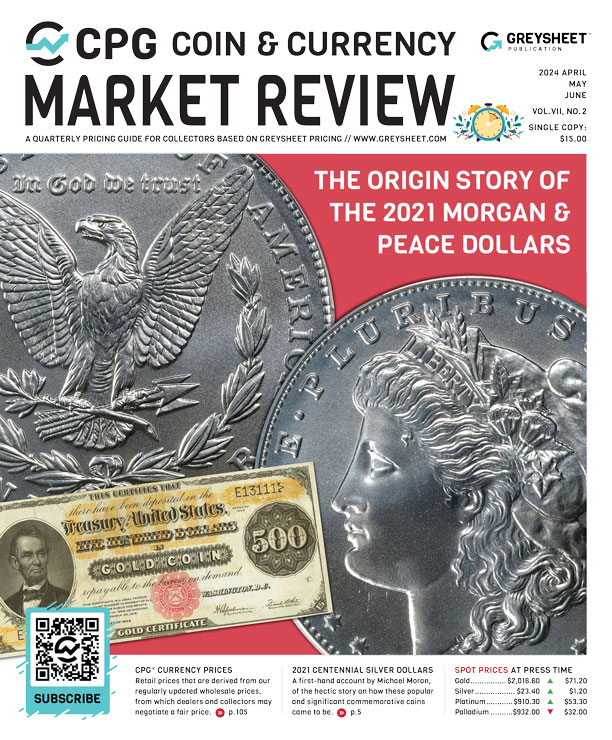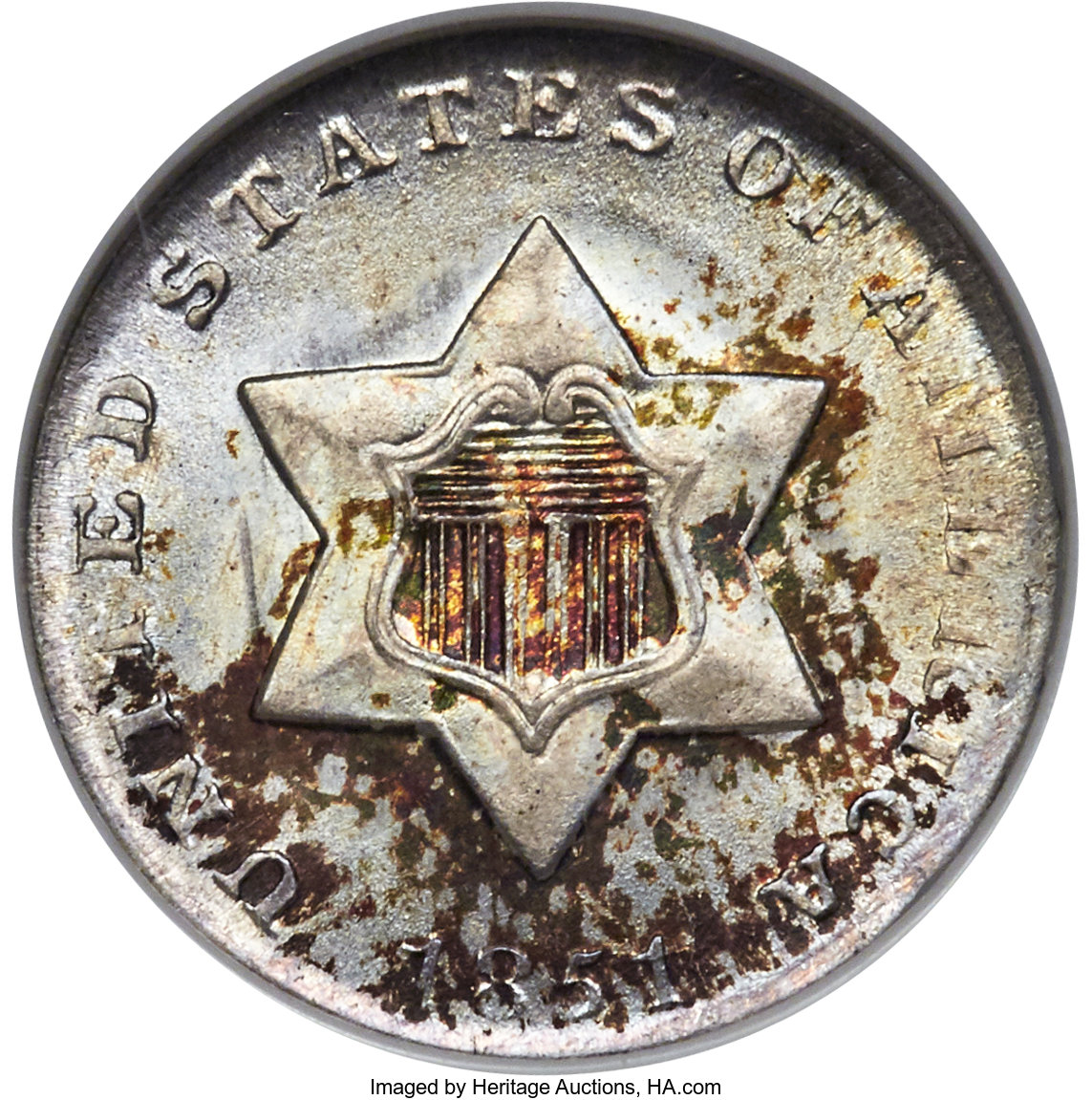Can You Spare A Trime? 3-Cent Silver Coins Popular With Collectors
Measuring only 14 millimeters in diameter and weighing four-fifths of a gram upon its release in 1851, the 3-cent silver coin is miniscule by every physical measure but a heavy hitter in the eyes of type collectors.
Measuring only 14 millimeters in diameter and weighing four-fifths of a gram upon its release in 1851, the 3-cent silver coin is miniscule by every physical measure but a heavy hitter in the eyes of type collectors. The 3-cent silver coin arose as a practical solution for postage payments at a time when domestic postal rates had fallen from five cents to three cents. The thin silver piece also served an important role as a much-needed small-denomination coin, and thus the 3-cent silver coin was heavily used for a period during the mid 19th century.
When the 3-cent silver piece emerged in the early 1850s, tiny circulating coins were a big deal. The United States Mint was still issuing half dimes, which debuted in 1794 and, in the early 1850s, measured just 15.5 millimeters wide and weighed 1.34 grams. Also making its rounds then was the gold dollar, which premiered in 1849 with a 13-millimeter diameter, making it America’s smallest coin; the gold dollar retains that title today, leaving the 3-cent silver piece the nation’s smallest silver coin and thinnest circulating issue ever struck by the United States Mint.
Back in the day, many folks colorfully referred to waif-like silver coins as “fish scales.” Today, numismatists are more likely to call 3-cent silvers “trimes,” a term that was contemporarily coined by James Ross Snowden, who served as director of the United States Mint from 1853 through 1861.
A Closer Look at Trimes
Numismatists recognize three primary varieties within the 3-cent silver series. All varieties share the same basic obverse and reverse designs by Chief Engraver James B. Longacre. The obverse features a shield superimposed upon a six-sided star and the reverse carries a Roman numeral “III” within a large, ornate letter “C.”
Variety I, struck from 1851-1853, has the plainest version of the main design in comparison to more ornate latter varieties and was struck with a 75% silver, 25% copper composition. It is with Variety I that collectors encounter the only mintmarked issue – the 1851-O from the New Orleans Mint. The “O” mintmark is located on the coin’s reverse, immediately to the right of the “C.”
With the introduction of Variety II in 1854, the United States Mint increased the coin’s silver content to 90% to promote further circulation of the 3-cent coin. Along with the change of alloy came a reduced thickness and lower weight, down from 0.80 grams to a mere 0.75 grams. There were also some minor design modifications, including the addition of a double-lined border around the star on the obverse; the reverse gained an olive sprig above the “III” and a bundle of arrows below the Roman numeral.
Striking issues necessitated a third and final design change in 1859, including a revised, single-lined border around the star and use of a taller, narrower letter font. Generally speaking, Variety III encompasses many of the coin’s scarcest issues and also includes some of the most notable varieties in the series, such as the 1862 2 Over 1. Furthermore, 3-cent silvers struck from 1860 through 1863 carry the smallest date numerals to appear on a circulating United States coin.
During the Civil War, from 1861 through 1865, many Americans hoarded trimes and other silver coins, not to mention small-denomination coinage such as 1-cent and 5-cent pieces. Circulating private tokens, encased postage stamps, and fractional paper currency helped carry Americans through the challenging nationwide coin shortage, which the United States Mint addressed with the issuance of new base-metal coins. Among these new issues, all designed by Longacre, are the copper 2-cent piece released in 1864, the 3-cent nickel that premiered in 1865, and the copper-nickel version of the 5-cent issue – now simply called the “nickel” – that debuted in 1866.
The Coinage Act of 1873 brought an end to production of the 2-cent coin, trime, and half dime. Meanwhile, the 3-cent nickel, simultaneously produced with its silver counterpart from 1865 through 1873, lasted until 1889. The 3-cent nickel’s demise was spurred in part by the reduction of the postage rate in 1882 from three cents to two cents. The 3-cent nickel’s diameter – 17.9 millimeters, identical to the dime – had also caused some degree of public confusion and created new problems with the introduction of mechanical coin-operated vending machines in the early 1880s.
Collecting Trimes
The hobby’s zenith of popularity in the 1950s and early ‘60s inspired the creation of an exciting variety of coin folders from leading coin supply companies such as Whitman, which at the time produced a blue tri-panel folder (#9023) for the entire 3-cent silver series. These days, it’s far more challenging to find any coin folders, coin albums, or coin display cases designed for storing the entire run of trimes. However, many popular type set holders do accommodate at least one portal for the inclusion of a single 3-cent silver coin, usually situated adjacent to a similar spot for a 3-cent nickel and other coins generally classified by modern numismatists as “odd denominations.”
Still, there are many enthusiasts who seek every date and variety, not to mention dedicated registry set builders who pursue the best third-party-graded examples. According to the CPG® Coin & Currency Market Review, common examples of 3-cent silver coins typically start between $25 to $50 for well-circulated examples from the early 1850s. Common Mint State examples easily command $250 to $500 each, with gem specimens climbing well into the four-figure range and beyond. Proofs usually trade for $350 to $1,000 each, with many higher-priced exceptions for better examples and scarcer proof issues.
In terms of mintages, the most common pieces among the short-lived series are from the 1850s, with six issues boasting production figures of more than 1 million pieces and three – the 1851 (Philadelphia), 1852, and 1853 – exceeding 5 million each. Two of those surpass production totals of 10 million each, with mintages of 18,663,500 and 11,400,000 for the 1852 and 1853, respectively. Meanwhile, the 1851-O, the only mintmarked issue among the series, saw a mintage of just 720,000. The Professional Coin Grading Service (PCGS) reports far fewer survivors today, with even the most common Philadelphia issues from the early 1850s each estimated to have perhaps only 25,000 to 35,000 surviving examples across all grades.
The 1872, arguably the key date of the series, saw a tiny mintage of only 1,000 pieces and has about 100 survivors, according to PCGS. Among these are perhaps only 40 specimens in uncirculated grades and a dozen grading MS-65 or higher. Trime expert Jon Lerner, who serves as the president of Scarsdale Coins in Mamaroneck, New York, says the 1872 may not be as scarce today as collectors once thought it was. “10 or 20 years ago, I would have said the 1872 was the key, but a fairly large number of 1872s has appeared on the market and we see that the 1868 has become the tough date for the series, especially in higher grades above MS-64.”
Lerner says 3-cent silvers dated between 1863 and 1873 are tough across the board. “The total mintage is under 100,000 pieces for all of those business strikes combined, and I would estimate that less than 5% of that number survive – that’s around 4,000 pieces. That really is the definition of scarce, insufficient for the demand. In fact, if demand rose among collectors the prices for the tough dates would skyrocket.”
While uncirculated examples of 3-cent silver coins are decidedly scarce, Lerner believes there are plenty of good deals to be found. “The big-money spenders have traditionally gone after the highest-grade [examples] for registry sets spending $10,000 to $50,000 for an MS-67 or MS-68. But the undervalued sweet spot would be two grade points less, where you could pick up a nice example for $2,000 to $6,000.”
Beyond regular-issue key dates and uncirculated 3-cent silvers, trime enthusiasts can stay busy searching for varieties. “There are actually quite a few interesting ones to look for,” Lerner says. “The holy grail would be the 1852 Inverted 1, of which perhaps five or six have been located.” The few known specimens are worth about $700 and up in the better circulated grades. Conversely, the 1862 2 Over 1 overdate is far more common and represents a ripe cherrypicking opportunity for astute collectors. “It’s often not labeled as such on slabbed holders.” The 1862 2 Over 1 overdate was discovered in the early 1960s and has become one of the most popular varieties in the series. PCGS estimates 3,000 specimens exist across all grades, with Fine-12 specimens trading for about $55 apiece, about the same price as similarly graded examples of “ordinary” 1862 trimes, which are roughly three times as common. Two other overdates, the proof 1863 3 Over 2 (listed as a “so-called” overdate in A Guide Book of United States Coins) and 1869 9 Over 8 are very scarce and are worth several thousands of dollars in choice grades, with PCGS listing 50 or fewer total survivors for each variety.
The Trime Market Is Diverse
Who’s buying 3-cent silver coins? “The collector for trimes is usually a bit younger, with the simple reasoning that the coins are smaller,” Lerner explains. “As we get older, we tend to gravitate to series of larger-sized coins. Hence, we see folks who like half dimes also like 3-cent pieces.” Lerner says the market generally goes two directions. “There are way too many common dates readily available, like the 1851 and 1852. But there is also strong demand for affordable pieces in the better dates.”
While series enthusiasts are certainly major players in the 3-cent silver market, a large share of trimes wind up in type sets. “Many of the 3-cent pieces are sold to type collectors who are either looking for just one nice example or perhaps three pieces – one of each type. “For the type collectors out there, here is what I would recommend: an 1851-O as a Type I, which is always in demand and is the only branch-mint date; 1855 is my suggestion for the Type II, as this is the toughest of the Type II and hard to find above MS-64; 1873 is a proof-only year, making it a nice coin to round out a type set as only 1,000 were minted – these are Closed 3.”
Interestingly, Lerner says those who collected trimes a century ago tended to mix business strikes and proofs in their 3-cent silver series sets. “In my research, I found that early collectors would collect 1851-1862 in business strikes and 1863-1873 in proofs,” he noted. “It’s a fun way to collect, affordable, and is a little outside the box.”

Download the Greysheet app for access to pricing, news, events and your subscriptions.
Subscribe Now.

Subscribe to CPG© Coin & Currency Market Review for the industry's most respected pricing and to read more articles just like this.
Source: CDN Publishing











